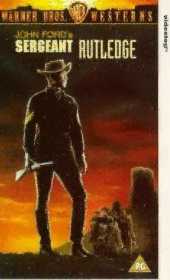Here's the plot:
Sergeant Rutledge
"It was all right for Mr. Lincoln to say we was free. But that ain't so! Not yet! Maybe someday, but not yet!"
—Sergeant Rutledge
The following sums up my reaction to the movie:
--Excerpt from Jonathan Rosenbaum's capsule at the Chicago Reader
The year is 1881. Geronimo was captured 2-3 years ago. But a band of Apaches has left the "San Rosario" reservation. Supposedly they want to "blood" themselves to prove they're warriors.
It's roughly the same conceit as in Fort Apache and Rio Grande. Apparently Ford didn't have a lot of original ideas. Or if he did, he didn't use them in setting up his movies.
Indians attack!
At least the Apaches in Sergeant Rutledge look authentic. And the use rifles rather than bows and arrows. But other than that, they're mindless savages.
You can find out how Sgt. Rutledge fared from many sources. (Hint: He's the hero.) Let's see how the Indians fared in the five scenes about them.
1) Left at the train station, Miss Mary Beecher finds the station master dead, shot in the chest with an arrow. As Rutledge flees the scene of the crime, he runs into Beecher. With no motivation or reason, two Apaches suddenly attack. They're literally faceless, since you can't see their faces clearly. Rutledge and Beecher shoot them dead, then forget about them.
2) After Cantrell and his black troops capture Rutledge, they ride after the Apaches, who have torched three ranches so far. They find young Hubble, the son of the trading post owner, staked out in the sun. (Hubble shouldn't be confused with Hubbell, who was a trading post owner in Arizona.) Hubble's body (off-camera) is smoking, so it seems the Apaches burned him. They probably burned him alive because they’re so evil.
3) After fleeing, the Apaches suddenly turn and charge the troops. Naturally they whoop like demons. But they ride around the mass of troops and present themselves as targets. They die because there military "strategy" is primitive and, frankly, stupid.
4) Rutledge gets away from the troops and heads for the river. There he sees the Apaches attacking the Beecher ranch--or at least riding around the corral waving their guns and whooping. Having captured old man Beecher, the Apaches shoot him in cold blood.
5) The Apaches lie in ambush for the troops as they cross the river, but Rutledge saves his comrades by warning them. Since stealth didn't work, the Apaches mount a head-on attack. (Apparently their motto is: "If at first you don't succeed in killing someone, try, try again.") Again they die because their strategy is stupid.
And that’s about it for the mindless savages.
The mythical Sergeant Rutledge
One other tidbit of Indian lore arises. Toward the end of the film, Cantrell finally says what we've been thinking: that this black regiment is the famed Buffalo Soldiers. From IMDB.com:
Rutledge is a paragon of virtue. He's as upstanding and honorable as Sidney Poitier in The Defiant Ones or Brock Peters in To Kill a Mockingbird (two great films). John Wayne could've played the Rutledge role without changing his speech or behavior.
So we have one of the best portrayals of a black person in fictional history. In a film that rejects racial myths and humanizes a minority, just as Huck Finn did 80 years earlier. Yet the same film depicts Indians as screaming beasts of prey. They have no recognizable human traits except killing and dying.
This is what Indians have had to deal with for 500 years. They were the first to be stereotyped and they're arguably the last. No other group would tolerate the racist and stereotypical caricatures that Indians routinely experience.
Despite its racist portrayal of Indians, Sergeant Rutledge is a fine film. Skip The Searchers and The Quiet Man hand and see this one instead. Rob's rating: 8.0 of 10.
P.S. For lots of images of Sergeant Rutledge, see John Ford's Sergeant Rutledge.


No comments:
Post a Comment
Note: Only a member of this blog may post a comment.